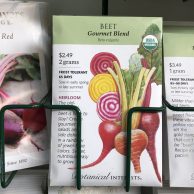
Some veggies seem to shy away from the limelight, flourishing underground to provide a surprising, beautiful, and nutritious surprise later in the season. Growing root vegetables is generally easy, and can be a fun way to engage children in gardening. In addition, mountain gardeners often find that root veggies thrive in their cooler conditions.
Once planted, root veggies do not like to be disturbed and therefore are best planted by seed. (We do sell Bull’s Blood Beets as a starts, but these are generally grown for their greens.) We have Botanical Interests, Masa, and Seed Savers Exchange seeds for many root veggies including:
- BEET Bull’s Blood, Chioggia, Detroizt Dark Red, Early Wonder, Gourmet Blend, Touchstone Gold
- CARROT Atomic Red, Carnival Blend, Dragon, Little Finger, Red Cored Chantenay, Scarlet Nantes, Shin Kuroda, Tonda di Parigi,
- LEEK Blue Solaise, King Richard
- ONION Cabernet, Italian Red of Florence, Walla Walla, White Lisbon, Zebrune
- PARSNIP All American
- RADISH Cherry Belle, Easter Egg Blend, Mantanghong, Miyashige White, Rudolf
To help you maximize your harvest, our friends at BOTANICAL INTERESTS SEEDS have put together top tips for growing root vegetables.
 Loose, well-drained soil is important to growing well-formed roots.
Loose, well-drained soil is important to growing well-formed roots.- Root vegetables are sensitive to root disturbance, so they should be sown directly in the garden.
- Root vegetables can be grown in deep (18” or deeper) containers.
- Since you harvest the entire plant at once, for a continuous supply, root vegetables should be sown in succession, sowing some every few weeks. Some root and many other succession crops can be found in larger seed packets, which are a better value.
- Root crops can stay covered with row cover until they are harvested to exclude several kinds of pests.
- Many root crops can be grown successfully in part sun—they just may take a little longer to mature.
- Many root vegetables make great storage crops. Just be sure to remove the greens (which are edible) before storing for longest storage.
See specific and detailed Botanical Interests’ Sow and Grow Guides for Carrots, Radishes, Beets, and Potatoes. And, learn how to stretch your root vegetable growing season with Successive Sowing!
